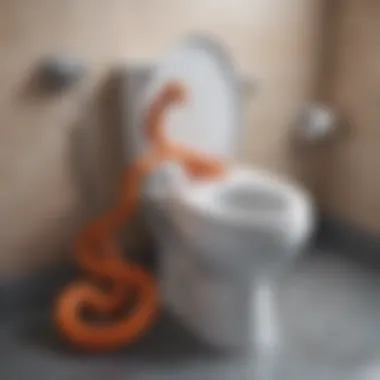A Comprehensive Overview of Hand Crank Toilet Snakes


Intro
Hand crank toilet snakes are crucial tools in plumbing, particularly for clearing clogs in residential and commercial toilets. Understanding how these devices function, their various types, and recent advancements in design can greatly benefit both homeowners and plumbing professionals. This article offers an extensive exploration of hand crank toilet snakes, discussing their definitions, uses, advantages, and limitations. By grasping their significance in plumbing maintenance, users can make informed decisions about when and how to utilize this essential tool.
Definition of Hand Crank Toilet Snakes
A hand crank toilet snake, also known as a toilet auger, is a mechanical device designed to remove blockages in toilet drains. The core components include a flexible metal cable, often with a spiral head, connected to a hand-operated crank. Users feed the snake into the toilet bowl until it encounters a clog. Cranking the handle spins the spiral head, allowing it to break up the blockage or retrieve materials causing the obstruction.
Operational Principles
The operation of hand crank toilet snakes relies on both physical and mechanical principles. When inserted into the drain, the flexible cable adapts to the bends and curves of the plumbing, enabling it to navigate through the pipes. As the user turns the handle, the force generated allows the spiral head to apply pressure on the clog, effectively dislodging or capturing it.
Types of Hand Crank Toilet Snakes
There are various models of hand crank toilet snakes, each offering specific benefits. Common types include:
- Standard Toilet Augers: These are designed for residential use and can handle typical household clogs.
- Heavy-Duty Toilet Snakes: Ideal for professional plumbers, these models can tackle more severe obstructions.
- Flexible Toilet Augers: With greater flexibility, they can maneuver through tricky plumbing configurations.
Advantages and Limitations
Advantages
- Effectiveness: Hand crank toilet snakes are reliable for many types of clogs, often providing quick resolution.
- Cost-Effective: Compared to calling a professional plumber, these devices save money for homeowners.
- Ease of Use: Most models are user-friendly, allowing individuals to resolve issues independently.
Limitations
- Physical Effort: The manual operation requires physical strength, which could pose challenges for some users.
- Not Suitable for All Clogs: For very severe or complex blockages, professional assistance may still be necessary.
- Risk of Damage: Improper use can lead to damage to the plumbing system or the toilet itself.
Innovations in Hand Crank Toilet Snakes
Recent advancements in the design of hand crank toilet snakes aim to enhance their effectiveness and ease of use. Innovations include:
- Improved Materials: Newer models feature corrosion-resistant materials, increasing durability.
- Ergonomic Designs: More comfortable handles reduce strain during operation.
- Integrated Lighting: Some models now include built-in lights for better visibility in dark spaces.
"Understanding the functionality and variations of toilet snakes empowers homeowners to efficiently tackle plumbing issues, thereby enhancing their household management skills."
Finale
Understanding Hand Crank Toilet Snakes
Hand crank toilet snakes are essential tools in the maintenance of plumbing systems. Understanding their function, design, and historical context helps in recognizing their importance in both residential and commercial environments. These tools provide a straightforward solution for unclogging toilets, allowing homeowners and professionals alike to manage one of the most common plumbing issues effectively.
Definition and Purpose
A hand crank toilet snake, often referred to as a toilet auger, is a mechanical device used to dislodge clogs in toilets and waste pipes. The primary purpose of this tool is to break through or retrieve blockages caused by materials such as toilet paper, grease, and foreign objects. Its design features a long, flexible cable and a crank handle, which allows the user to manually operate the tool, offering a methodical approach to restore proper flow in plumbing systems.
The ability to exercise control when using a hand crank toilet snake is one of its key advantages. The operator can gauge how much pressure to apply and whether to continue cranking, making it suitable for various clog situations. Unlike chemical drain cleaners that can be hazardous, the hand crank snake provides a physical means of resolving blockages without introducing potentially harmful substances into the plumbing.
Historical Context
The concept of using a simple mechanical tool for plumbing dates back to the 19th century. Early versions of toilet snakes were rudimentary, often consisting of a coiled wire. The invention of the hand crank mechanism enhanced user control and efficiency dramatically.
Over the decades, the designs have evolved. Techniques have expanded, incorporating more durable materials and ergonomic features. This evolution signifies a growing understanding of plumbing needs, showcasing how necessity drives innovation.
The hand crank toilet snake represents a bridging of practical plumbing solutions with technological advancements. Its continued popularity lies in its reliability and accessibility, confirming its relevance in modern plumbing practices.


Mechanics of Operation
Understanding the mechanics of hand crank toilet snakes is vital for anyone looking to utilize this plumbing tool effectively. These devices are designed for the specific purpose of clearing clogs within toilet systems. By grasping how they function, users can appreciate their advantages and limitations when tackling plumbing challenges.
How the Device Works
Hand crank toilet snakes operate on a simple yet effective principle. They consist of a flexible cable that extends into the toilet bowl to reach clogs. By turning the crank handle, the user advances the cable into the drainage system. The crank’s motion rotates the cable, allowing it to maneuver through twists and turns in the pipes. This movement helps the head of the snake to break apart or latch onto obstructions, assisting in their removal. Understanding this operational method is crucial for effectiveness in real-life situations when managing plumbing issues.
Components of a Hand Crank Toilet Snake
A hand crank toilet snake consists of several core components, each contributing to its overall functionality. These elements include the crank handle, the cable, and the clog removal head.
Crank Handle
The crank handle is perhaps the most user-friendly aspect of the device. As a lever, it enables the user to apply consistent force throughout the unclogging process. This specific feature distinguishes it from other plumbing tools. An ergonomic design is advantageous as it allows users to maintain a grip without excessive strain. Nevertheless, the strength of the material is essential; it should endure repeated use without breaking down. A common disadvantage, however, is that prolonged use can tire the hands, making it essential to take breaks during the unclogging process.
Cable
The cable is a crucial part of the toilet snake. Typically made of steel or similar durable materials, it must be flexible yet sturdy enough to navigate through pipes. The key characteristic of the cable is its ability to withstand bending and resist kinks. Such features make it fit for purpose, helping it reach deeper blockages effectively. However, one downside is that consistent pressure can lead to wear and tear over time, necessitating replacement or repair.
Clog Removal Head
The clog removal head at the end of the snake is specifically designed to address various blockages. Its shape can vary, featuring designs such as augers or spirals tailored to tackle different types of clogs. This part's primary advantage lies in its functionality; it can effectively break up debris or retrieve stubborn materials stuck in the pipes. The downside, though, is that the wrong design can sometimes fail to effectively dislodge certain types of clogs, which must be kept in mind when selecting a snake for a specific job.
Types of Hand Crank Toilet Snakes
Understanding the various types of hand crank toilet snakes is crucial for effective plumbing maintenance. Different models cater to specific needs and preferences, impacting both usability and efficiency in unclogging toilets. This section will focus on the two primary categories of hand crank toilet snakes, providing insights into their features and benefits.
Manual vs. Electric Variants
Manual hand crank toilet snakes operate through physical effort, relying on the user to turn the crank. This traditional method offers several advantages, such as low cost, simplicity, and no need for batteries or electricity. For those who prefer a hands-on approach, manual variants provide better control over the unclogging process.
The electric versions, on the other hand, enhance the experience by leveraging mechanical power. They operate more efficiently, often reducing the time needed to clear clogs. Electric toilet snakes can handle tougher blockages without requiring as much physical exertion from the user. However, they tend to be more expensive, and users need to be cautious of electrical safety.
Some key factors to consider between these two types are:
- Cost: Manual options are generally cheaper than electric models.
- Usability: Electric variants can be more user-friendly for frequent use.
- Effectiveness: While both can be effective, electric snakes may handle larger clogs better.
Size and Length Variations
Toilet snakes come in various sizes and lengths, making selection crucial based on the specific plumbing situation. A common length for home use is around 25 feet, which typically suffices for standard residential plumbing. However, longer options, extending to 50 feet or more, are available for commercial purposes or more challenging clogs deep within the pipelines.
The size of the clog and the plumbing's configuration can determine the ideal snake length. Shorter snakes may maneuver easily in tight spaces, whereas longer snakes are necessary for reaching deeper obstructions.
When thinking about choosing the right size and length, keep in mind:
- Type of plumbing: Older pipes may require more delicate handling with shorter snakes.
- Nature of clogs: Determine the common types of clogs encountered to select a suitable length.
- Storage and portability: Longer snakes may require more storage space and can be less portable.
In summary, the types of hand crank toilet snakes, whether manual or electric, and the size variations both play vital roles in effective plumbing maintenance. Assessing your needs will ensure you choose the right tool for optimal performance.
Advantages of Using Hand Crank Toilet Snakes
Hand crank toilet snakes offer several key advantages, making them a preferred choice for many homeowners and plumbing professionals. Understanding these benefits can help one appreciate the tool's effectiveness in tackling common plumbing issues without requiring extensive expertise or resources.
Cost-Effectiveness
One significant advantage of using hand crank toilet snakes is their cost-effectiveness. Unlike electric augers, hand crank versions are typically much more affordable. The purchase price is low, and they do not require electricity, reducing operating costs. This is crucial for homeowners who want to manage minor clogs without calling a plumber.


Moreover, hand crank toilet snakes are durable and can last a long time with proper maintenance. This longevity ensures that the initial investment pays off over time. Materials used in construction, often stainless steel or high-grade plastics, are chosen for durability, allowing the tools to withstand the rigors of repeated use.
Another point of cost-effectiveness relates to the ability of users to perform their plumbing repairs. When homeowners can clear minor clogs, they avoid the expense of hiring professional plumbing services. This gives a sense of empowerment to individuals who may otherwise feel dependent on outside help.
Manual Control and Precision
Hand crank toilet snakes provide users with significant manual control and precision when tackling clogs. Unlike powered devices, the manual operation allows one to sense the tension and resistance in the snake directly. This feedback is vital for determining how to proceed effectively.
Users can adjust their approach based on the feedback they receive. For example, if a clog feels particularly stubborn, they can carefully manipulate the snake’s movements to either work through the blockage or avoid damaging the toilet’s internal components. This level of control is essential to ensure that users navigate the plumbing system without causing unintended harm.
Additionally, the precision offered by manual cranking enables targeted efforts on specific areas of the clog, enhancing the likelihood of successful removal. This method can lead to a more efficient clogged toilet clearing process, minimizing the time and effort involved.
"Manual operation allows for a more tactile experience, providing real-time feedback that electric versions cannot offer."
Limitations and Considerations
Understanding the limitations and considerations regarding hand crank toilet snakes is important. This section uncovers potential challenges and practical factors that users must take into account when using these tools. Hand crank toilet snakes are helpful for clearing clogs, but they are not foolproof solutions. Awareness of their limitations can lead to better decision making and more effective plumbing maintenance.
Physical Labor Involved
Using a hand crank toilet snake requires a certain degree of physical effort. The manual operation of these devices can be taxing, particularly in challenging situations. This makes it essential for users to be prepared for physical work when they set out to address a clog. The repetitive cranking action can lead to fatigue, especially when dealing with stubborn blockages.
Working with a hand crank toilet snake can also involve awkward body positions. Users often need to maneuver in cramped spaces and may need to kneel or bend for prolonged periods. This can lead to discomfort or strain. It is advisable to take breaks, stretch, and ensure proper posture to minimize the risk of injury.
Not Suitable for Severe Clogs
While hand crank toilet snakes are effective for many types of clogs, they may not be suitable for severe ones. For example, deeply rooted blockages or those caused by foreign objects may require more advanced plumbing solutions. In these cases, users might find themselves frustrated if their hand crank snake fails to resolve the issue.
Hand crank toilet snakes are best used for moderate obstructions such as hair clogs or small debris. If a blockage is particularly severe, it might require professional assessment and intervention. Recognizing the limitations of these tools can prevent unproductive attempts and save time in managing plumbing issues.
Best Practices for Use
Using a hand crank toilet snake effectively requires understanding the best practices that ensure the tool is effective and safe. These methods not only enhance the efficiency of unclogging toilets but also prolong the life of the tool. Following recommended practices minimizes damage to the plumbing system and reduces the risk of injury during use.
Step-by-Step Usage Guide
- Preparation: Before initiating the process, gather all necessary tools and supplies. Apart from the hand crank toilet snake, have rubber gloves and a bucket ready. Wearing gloves protects against potential contaminants in the toilet.
- Positioning: Approach the toilet carefully. Place the end of the snake into the toilet bowl while ensuring the crank handle is placed securely within your grip. This positioning provides optimal control in the following steps.
- Insertion: Slowly turn the handle to insert the cable into the drain. Apply gentle pressure while inserting, as forceful pushing may damage the plumbing.
- Cranking: When the cable meets resistance, continue cranking. This motion allows the guide to break through the clog. Make gradual, steady turns; jerking or forcing can damage the tool and plumbing.
- Retrieval: After breaking through the clog, pull the snake out slowly. Always inspect the end of the cable. If debris is present, dispose of it in a bucket, not the toilet.
- Testing: After removing the snake, flush the toilet to ensure the flow is clear. A successful unclogging will show immediate results with aided water movement.
Maintenance and Care Tips
Effective maintenance of a hand crank toilet snake extends its useful life and enhances performance. Consider the following care tips:
- Cleaning: After each use, rinse the cable and head thoroughly to remove any debris. A clean snake is less likely to cause future clogs.
- Drying: Allow the cable to dry completely before storing. Storing a wet snake can lead to rust and deterioration. Ensure it is placed in a dry, ventilated area.
- Lubrication: applies a light lubricant on the moving parts periodically. This practice helps in maintaining smooth operation when cranking the handle.
- Inspection: Regularly check for wear and tear on the components. If you spot frayed cables or a damaged crank handle, consider repairing or replacing the tool.
Regular maintenance will not only increase the tool's lifespan but will also improve its effectiveness in unclogging toilets.
Employing these tools and practices will not only enhance the effectiveness of your hand crank toilet snake but also safeguard plumbing systems and the users during the unclogging process.
Innovations in Toilet Snake Technology
The field of plumbing is not static. Technological advancements constantly reshape the tools professionals use, including hand crank toilet snakes. Innovations in this area enhance both efficiency and user experience. These upgrades not only improve clog removal effectiveness but also contribute to safer, more sustainable practices in plumbing.
Smart Toilet Snakes
The introduction of smart toilet snakes represents a significant leap in plumbing technology. These devices integrate digital tools with traditional mechanics. Smart toilet snakes often feature sensors that detect the type and severity of a clog. Such technology provides real-time feedback to users, helping them decide the best course of action.


The benefits of smart toilet snakes include:
- Enhanced diagnostics: Users can know the exact nature of the blockage, which aids in planning the unclogging process.
- User-friendly interfaces: Many smart models come with mobile app integration. This allows users to monitor their plumbing systems remotely.
- Increased efficiency: These devices tend to work faster, as they adapt their operation based on clog data.
Although still emerging, smart toilet snakes are gaining traction. Homeowners and plumbing professionals alike are beginning to appreciate the advantages they provide.
Advancements in Materials Used
Another critical area of innovation involves the materials used in the construction of toilet snakes. Modern manufacturing techniques have led to the development of stronger and more flexible materials.
Recent advancements include:
- High-strength cables: New materials make cable components less prone to breaking under pressure. This durability extends the life of the tool.
- Corrosion-resistant coatings: These protect the snake from damage caused by water and waste substances. This feature ensures longevity in tough environments.
- Lightweight composites: Using lighter materials makes these tools easier to handle. Ergonomics play a key role in user experience, reducing strain during operation.
The materials used in toilet snakes have a direct impact on their effectiveness and usability. Enhanced materials contribute to a more reliable device that meets the rigorous demands of plumbing tasks.
Common Misconceptions
Understanding common misconceptions about hand crank toilet snakes is crucial for both homeowners and plumbing professionals. Misunderstandings can lead to inefficient use of these tools and even discourage individuals from employing them correctly. Addressing these misconceptions helps clarify the true value of hand crank toilet snakes.
It's Only for Emergencies
A prevalent belief is that hand crank toilet snakes are only necessary in emergencies. While these tools are indeed valuable during urgent plumbing situations, they should not be viewed solely as a last-resort solution. Regular use of a toilet snake can aid in preventative maintenance, ensuring that pipes remain clear over time.
By removing small clogs before they escalate, homeowners can save themselves from larger, more complicated plumbing issues. It is more prudent to consider the snake as a regular part of home maintenance, not just a tool for emergencies.
Many plumbing professionals recommend that homeowners familiarize themselves with their hand crank toilet snakes. By doing so, they can effectively manage minor clogs as they arise. This proactive approach can prevent further complications that could require professional intervention.
All Snakes Are the Same
Another misconception is the belief that all toilet snakes function similarly. This is far from the truth. While the basic purpose of a toilet snake is to remove clogs, the methods and features can vary significantly among different models.
Some key differences include:
- Length and Size: Various models are designed for specific types of toilets and plumbing configurations.
- Cable Construction: Snakes may have different cable types that offer varying strength and flexibility.
- Head Design: The clog removal heads often differ in shape and mechanism, affecting their effectiveness.
Misunderstanding these characteristics can lead to the ineffective application of toilet snakes in certain situations. It is essential to choose a tool tailored to one’s specific plumbing needs.
Proper choice of a hand crank toilet snake can significantly affect plumbing efficiency. Avoid assuming that all options provide the same result.
Closure: The Role of Hand Crank Toilet Snakes in Plumbed Environments
Hand crank toilet snakes serve a vital function in maintaining the efficacy of plumbing systems. These tools are not only useful but also essential for both homeowners and professionals in plumbing. Their design allows for a hands-on approach to addressing clogs, providing a solution that is often more immediate than traditional plumbing methods.
In the realm of plumbing, the presence of a hand crank toilet snake can make a significant difference. They allow users to exert control over the clog removal process. This ability to determine the intensity and direction of force applied is crucial. Often clogs are unexpected, and having the right tool on hand saves time and prevents potential damage.
"The right tools are key in preventing plumbing chaos and ensuring home comfort."
The effectiveness of a hand crank toilet snake lies in both its simplicity and the mechanics offered by its design. They are not only economical but also environmentally friendly, reducing the need for chemical solutions that can harm piping over time. It’s necessary to incorporate this tool with an understanding of its limitations, allowing the user to apply it appropriately to the situation at hand for maximum impact.
Summary of Key Points
In summarizing the discussions throughout this article, the following key points emerge:
- Definition and Purpose: Hand crank toilet snakes are tools designed for unclogging toilets effectively.
- Mechanics of Operation: They work by enabling users to manually manipulate a cable that extends into plumbing to clear obstructions.
- Advantages: They provide a cost-effective solution and promote manual control without reliance on powered devices.
- Limitations: These tools require physical effort and are not recommended for severe clogs that may require professional attention.
- Innovations: Ongoing developments, like smart technology and advanced materials, are enhancing the functionality of toilet snakes.
Future Outlook for Hand Crank Tools
The future of hand crank toilet snakes appears promising. As technology progresses, manufacturers are increasingly focusing on refining these tools to meet diverse plumbing needs.
Hand crank designs may incorporate smarter features, such as sensors to gauge the severity of the clog. Innovations could lead to improved ergonomic designs, making these tools easier and more comfortable to use. Furthermore, advancements in materials may enhance their durability and effectiveness.
Moreover, the growing trend towards sustainability in consumer products suggests that more environmentally conscious versions of toilet snakes will come to the market. Overall, hand crank toilet snakes will likely maintain their relevance, adapting to industry demands and expanding their utility for both casual users and plumbing professionals alike.



